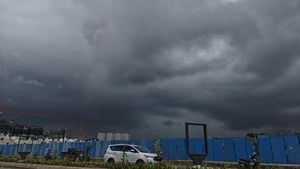The United States has once again thrust its H-1B visa program into the national spotlight, sparking debate and anxiety both at home and abroad. On October 30, 2025, the U.S. Department of Labor released a 52-second video advertisement that accused foreign workers—most notably those from India—of "stealing the American dream" through what it described as the rampant abuse of the H-1B visa system. The video, which quickly circulated on social media, features a pie-chart graphic that leaves little room for ambiguity: India holds the lion’s share of H-1B visa approvals, at a striking 72 percent, followed by China (12 percent), Canada and the Philippines (1 percent each), and a catch-all "other" category at 14 percent.
According to the Department of Labor’s official X (formerly Twitter) handle, the video’s narrator intones, "Many young Americans have had this dream stolen from them by foreign workers as politicians and bureaucrats allowed companies to abuse the H-1B visa." The message is clear, and the tone is unmistakably urgent. The ad’s closing line, "Recapturing the American Dream for the American people," underscores the administration’s intent to prioritize Americans in the hiring process and clamp down on perceived visa exploitation.
This latest move comes as part of President Donald Trump’s broader "America First" agenda, a policy platform that has consistently promoted protectionist measures and a hardline stance on immigration. The timing is hardly accidental: with an election cycle looming, the administration appears keen to reinforce its commitment to American workers and to highlight its efforts to curb foreign competition in the domestic job market.
Central to the ad’s message is "Project Firewall," a Labor Department initiative launched in September 2025 to audit H-1B visa compliance. The project aims to prevent companies from replacing American workers with lower-paid foreign professionals and to hold employers accountable for any misuse of the visa system. The ad states, "Through Project Firewall, we’re taking action to hold companies accountable for H-1B abuse and ensure they prioritize Americans in the hiring process, recapturing the American Dream for the American people."
But what exactly is the H-1B visa, and why has it become such a lightning rod for controversy? The H-1B program allows U.S. employers to hire foreign professionals in specialized fields such as information technology, engineering, medicine, and science. Typically, the visa is granted for three years and can be extended for another three, enabling workers to live and work legally in the United States while employed by a sponsoring company. According to the Department of Homeland Security, India remained the top source of H-1B visa holders in fiscal year 2024, accounting for 33 percent of the total non-immigrant population in the U.S.
For decades, Indian professionals have formed the backbone of America’s tech industry, filling critical gaps in STEM fields and contributing to the country’s global competitiveness. As reported by Business Today, India’s dominance in the H-1B program is not new, but the recent video has reignited tensions in the so-called India-U.S. job corridor. The ad’s accusatory language and nationalistic overtones have caused concern among tech firms, the Indian diaspora, and foreign workers who depend on the program for their livelihoods.
The anxiety has only been compounded by a series of restrictive measures rolled out in recent months. On September 19, 2025, President Trump signed a proclamation imposing a one-time $100,000 fee on new H-1B visa applications, a move that went into effect on September 21. The decision triggered widespread panic, particularly among Indian professionals and the tech sector, where reliance on H-1B talent is especially pronounced. The White House later clarified that the fee is a one-time payment—not an annual charge—and does not affect current visa holders. Officials have defended the hike, arguing that it will ensure only "highly skilled" foreign professionals, those who cannot be replaced by American workers, are granted entry.
In the weeks following the fee increase, U.S. authorities announced another significant change: the end of automatic extensions for Employment Authorization Documents (EAD) for foreigners filing renewals on or after October 30, 2025. The Department of Homeland Security stated that the new rule aims to prioritize proper screening and vetting of foreigners before extending the validity of their employment authorizations or work permits. This policy shift is likely to affect a large number of Indian immigrants and workers, adding another layer of uncertainty to an already fraught process.
The rhetoric surrounding these changes has been polarizing. Supporters of the Trump administration’s approach argue that the measures are necessary to protect American jobs and restore opportunities for U.S. citizens. They point to longstanding grievances about companies allegedly using the H-1B program to undercut domestic wages and displace American workers. "Young Americans have had the American Dream stolen from them, as jobs have been replaced by foreign workers due to rampant abuse of the H-1B visa," the Department of Labor’s video declares, echoing a sentiment that resonates with some segments of the electorate.
On the other hand, critics contend that the administration’s actions are short-sighted and risk undermining America’s position as a global leader in innovation and technology. Many in the tech industry argue that foreign professionals fill essential roles that cannot be easily replaced by domestic workers, especially in highly specialized fields. The $100,000 fee, they say, is "practically unaffordable" and will discourage talented individuals from seeking opportunities in the U.S., ultimately harming American companies and the broader economy.
For the Indian diaspora, the stakes are especially high. As ABP Live reports, the new policies have sparked "widespread concern" among Indian professionals and their families, many of whom have built lives in the U.S. over years—sometimes decades—of hard work and perseverance. The sudden imposition of steep fees and the threat of losing work authorization have left many feeling anxious and uncertain about their future.
Meanwhile, the political messaging is unmistakable. By framing the H-1B issue as a fight to "recapture the American dream," the Trump administration is betting that its tough stance on immigration will resonate with voters concerned about job security and economic opportunity. The video’s closing slogan, "Recapturing the American Dream for the American people," is a rallying cry that encapsulates the administration’s broader campaign promise to put Americans first, even as critics warn of unintended consequences for the country’s technological edge and international reputation.
As the debate rages on, one thing is clear: the H-1B visa program has become a flashpoint in the ongoing struggle to balance economic needs, national identity, and the aspirations of millions—both in the United States and around the world. With new policies in place and more likely on the horizon, the future of America’s relationship with foreign talent hangs in the balance.




